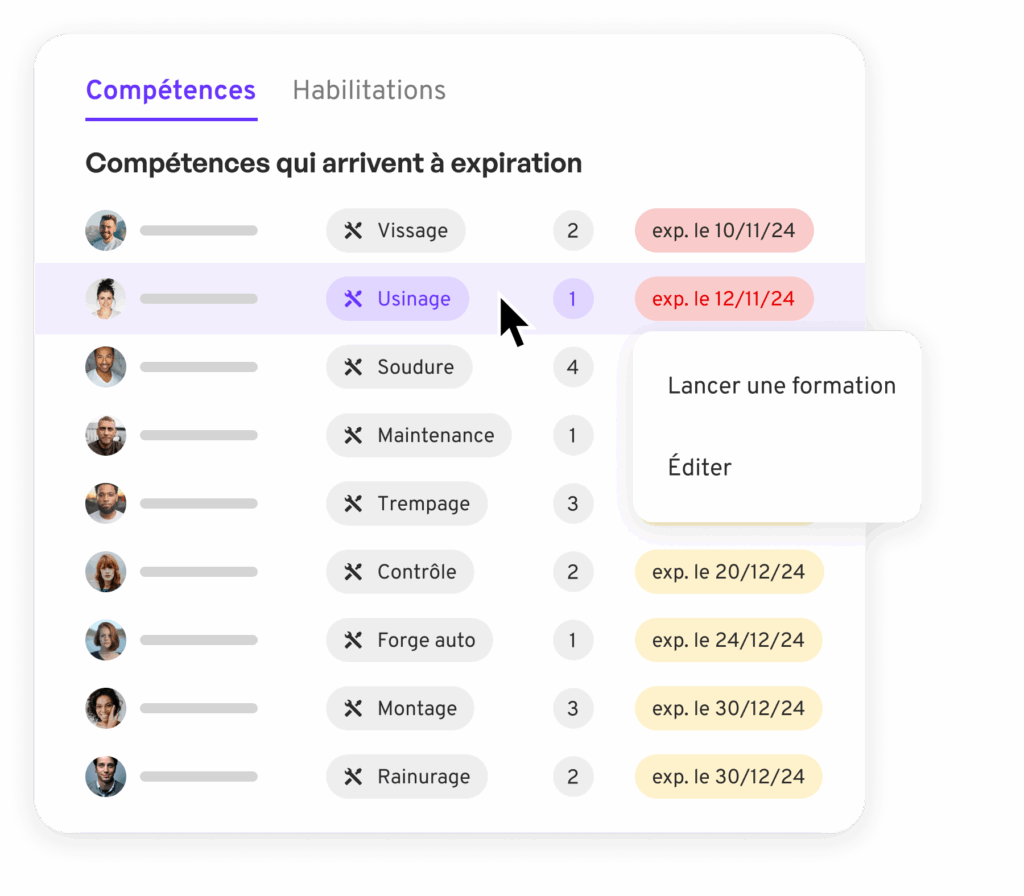The crucial importance of optimizing the skills matrix in the industrial sector
The modern industrial landscape: a competitive environment
Industry is a dynamic environment, and more than ever, attention to detail can make all the difference in terms of competitiveness and success. As we move increasingly towards a globalized economy, the pressure to remain agile, efficient and precise has never been greater. This is particularly true in manufacturing industries, where production often has to meet stringent international standards. So, in this competitive environment, optimizing the skills matrix is becoming more than a luxury; it's an imperative necessity.
Another aspect to consider is the rapid pace of technological innovation. Industrial organizations must continually update their skills and knowledge to remain competitive. Without a carefully designed and regularly updated skills matrix, companies risk being left behind, losing their competitive edge.
The intimate connection between skills matrix and industrial performance
An often overlooked but essential aspect of success in industry is the alignment between employee skills and organizational goals. An optimized skills matrix acts as a bridge between these two elements, providing a transparent, searchable table that guides the distribution of tasks and responsibilities. It can be particularly useful in identifying areas where further training is required, enabling employees to develop professionally while increasing the organization's efficiency.
Think of the competency matrix as a GPS for your industrial business. You wouldn't embark on a long journey without some form of navigation; likewise, navigating the competitive industrial landscape without a well-defined skills matrix can lead to delays, extra costs and, ultimately, lost business.
It's not just a question of who can do what, but also of understanding how skills align with your company's long-term objectives. For example, if one of your goals is to integrate more automated technologies into your manufacturing process, then your skills matrix needs to reflect the skills and training required to achieve this goal. Omitting this detail could lead to costly mistakes and inefficiencies that jeopardize overall company performance.
In a market where every minute and every skill counts, a neglected or obsolete skills matrix can cause significant disruption to operations. Consequently, companies that fail to give due importance to this powerful tool are setting themselves up for a loss of productivity and an inevitable erosion of their market position.
How to Choose the Right Performance Indicators for Your Competency Matrix
Having identified and balanced the skills required within your manufacturing organization, the right choice of Key Performance Indicators (KPIs) is the next crucial step. The KPIs you select must be perfectly aligned with your company's strategic objectives. For example, if minimizing downtime is a priority, KPIs such as mean time to resolve machine malfunctions would be relevant.
Quantitative KPIs : The essential metrics
In contrast to less tangible measures, quantitative indicators offer a clear and measurable assessment of performance. KPIs such as job duration, error rate and machine utilization rate are often used to assess efficiency and performance. These measures are particularly useful as they provide actionable data for ongoing optimization.
Integrate KPIs into Your Tracking for Ongoing Assessment
Incorporating well-chosen KPIs is also essential for real-time monitoring and ongoing evaluation of your skills matrix. This is crucial for identifying areas requiring rapid intervention, and for tracking performance over time. This ensures that your matrix remains a dynamic tool, always aligned with the needs of your industrial organization.
In short, KPIs are not just performance indicators, but also strategic steering tools. Their selection and constant monitoring enable you not only to assess operational efficiency, but also to make informed strategic decisions for future improvements.
Common mistakes to avoid when optimizing the skills matrix in industry
Even the most powerful tools can become useless if misused. In the industrial context, where mistakes can be costly, it's essential to be aware of common pitfalls when setting up a skills matrix. Here are some typical mistakes that could erode the effectiveness of your skills matrix, and how to avoid them.
Avoidance of employee self-assessment
One of the most common mistakes made when deploying a competency matrix is to neglect the employee self-assessment phase. Although this may seem a pointless, even subjectively biased step, self-assessment is in fact a strategic lever for the success of the skills matrix.
Employees are often in the best position to identify their own skills and shortcomings. Their self-assessment can provide a rich and nuanced database for professional development. What's more, involving employees in this process can increase their commitment and motivation, as they feel listened to and valued. Ignoring this step can lead to a lack of transparency and a deficit in the planning of training and development needs.
Ignoring the importance of versatility
The industrial sector requires a certain versatility skills. Specialization, while important, is no longer the only factor for success. In a world of interconnected supply chains, where speed and agility have become competitive advantages, versatility is essential.
By neglecting to integrate versatility into your skills matrix, you expose yourself to unnecessary risks. For example, if a specialized employee is absent or leaves the company, the skills gap can lead to delays and additional costs. Encouraging and valuing versatility not only provides you with a more agile workforce, but also enables you to optimize resource allocation in line with fluctuating industry needs.
The crucial role of digital tools in optimizing your industrial skills matrix
In the age of digital transformation, the importance of digital tools in managing and optimizing the skills matrix cannot be underestimated. With the rapid evolution of technology, industrial companies have at their disposal a variety of tools that can not only make skills management more efficient, but also more accurate.
Why is specialized software an essential investment in skills management?
The growing complexity of industrial operations requires tools that go beyond the simple Excel spreadsheet for skills management. A software specialized in skills management is a must-have solution for companies seeking a more comprehensive and dynamic picture of their team's skills. Robust platforms offer not only options for tracking and storing skills data, but also sophisticated analytics capabilities. These analytics can help inform strategic decisions, providing actionable insights into aspects such as performance, efficiency and even readiness for scaling up.
Although the initial investment may seem onerous, the long-term benefits in terms of operational efficiency, reduced error rates and better allocation of human resources more than justify the cost. In this context, software such as Mercateam stands out for its tailor-made solutions for the industrial sector.
Real-time dashboards: The barometer of your organizational performance
Real-time monitoring is the backbone of effective skills management, and here interactive dashboards show their true value. A well-designed dashboard provides an instant overview of key performance indicators (KPIs), enabling managers and employees to identify areas of strength and areas requiring rapid intervention.
The advantage of a real-time dashboard is its customizability; it can be tailored to display the metrics that are most relevant to your organization. Whether you want to track the time it takes to complete a specific task, or the error rate, a dashboard can be configured to track these KPIs.
What's more, a real-time dashboard fosters a culture of self-improvement within the team. Instant visibility of performance can act as a catalyst to encourage employees to close skill gaps, which in the long term contributes to the overall effectiveness of the organization.
Best practices for implementing your skills matrix
To get the most out of your skills matrix, it's crucial to follow best practices that guarantee its success and effectiveness.
The role of managers in deployment
Managers play a crucial role in the effective deployment of the skills matrix. Their responsibility goes beyond simple supervision: they must actively participate in assessing competencies, defining objectives and implementing action plans. Managers must also be trained in the use of dedicated digital tools and software to ensure optimal and uniform use across the organization.
Skills matrices available on Mercateam
Mercateam offers different types of matrices that are essential for optimal skills management:
- Polycompetence Matrix This matrix reveals the diversity of skills within each employee, enabling a more flexible and efficient distribution of tasks.
- Enabling matrix This matrix serves as a directory of the qualifications required for each position. It acts as a health book for skills, indicating the clearances each employee holds, which is crucial for compliance and safety in industrial environments.
Key steps to successful implementation
- Skills identificationThis is the first and perhaps most crucial step. Clearly identify the skills needed for each position.
- EvaluationUse proven assessment methods to measure these skills.
- Level definitionEstablish different levels of competence to give a scale of evaluation.
- Employee IncorporationInvolve employees in the process.
- ControlBefore rolling out on a large scale, carry out a pilot project to identify any adjustments that may be necessary.
- Deployment and follow-upOnce everything is in place, follow up regularly to maintain and update the matrix.
How can you measure the effectiveness of your skills matrix?
KPIs to track
Once your matrix is in place, it's essential to measure its effectiveness so that you can adjust your approach if necessary. Visit key performance indicators (KPIs) such as training completion rates, employee turnover rates, or even specific indicators such as the time it takes to complete a task can be useful measures of the effectiveness of your skills matrix.
The importance of regular reviews
It's not enough to set up a matrix and forget about it. Regular reviews are essential if it is to remain effective. This can be done at different levels: individual reviews, team reviews, or organizational reviews. These reviews enable the matrix to be updated in line with changes in skills, roles and corporate objectives.
Conclusion
In short, an effective skills matrix is an essential lever for any industrial company striving for operational excellence. It not only enables better allocation of human resources, but also promotes alignment between individual and organizational objectives. Digitizing this matrix offers undeniable advantages, from simplifying processes to providing usable data for strategic decisions. However, its success depends heavily on management commitment and employee adoption. Avoiding common pitfalls such as poor communication and a lack of flexibility can make the difference between a stagnant skills management system and one that propels the company to new heights of performance.




